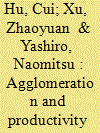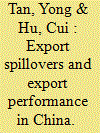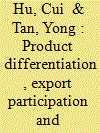| Srl | Item |
| 1 |
ID:
143433


|
|
|
|
|
| Summary/Abstract |
This paper conducts an in-depth evaluation on the role of industrial agglomeration in productivity growth of China's industrial sector by exploiting large dataset of manufacturing firms active in 176 three-digit industries and in 2860 counties. We also complement our analysis with the 2004 Census data to capture the agglomeration of small firms. Unlike previous studies that often focused on specific industries, we assess the impact of agglomeration in a comprehensive range of industries and extend the scope of analysis to upstream industries as well. Moreover, we explore how the ownership of Chinese firms shapes their ability to benefit from agglomeration effect as well as to act as the source of externality. We find that congestion and fiercer competition offset the benefits of agglomeration for firms operating within agglomerated regions. On the other hand, a co-location of large firms contributes significantly to productivity. We also find a more important contribution from the agglomeration of upstream industries than from that of the same industry. Private enterprises are the primary source of agglomeration effects especially in upstream industries, whereas their productivity is boosted most by the agglomeration of other private enterprises. We reckon that industrial agglomeration contributed up to 14% of the productivity growth in China's industrial sector between 2000 and 2007.
|
|
|
|
|
|
|
|
|
|
|
|
|
|
|
|
| 2 |
ID:
149762


|
|
|
|
|
| Summary/Abstract |
This paper examines the local export spillover effect on the individual decisions to start exporting (the extensive margin) and export volume (the intensive margin), using a unique dataset of Chinese export firms, at the product-level and by destination country. Based on a gravity-type equation estimated at firm-level, we find that export spillovers positively influence not only the decision of a nearby firm to start exporting, but also the volume of the exporting. Several methods are used to verify the robustness of these results. In addition, we find that the effect of export spillovers is stronger when it is product-destination-specific than that when it is either product or destination-specific alone, and also stronger than that is in general. Geographically, local export spillovers exhibit spatial decay in China: the effect is stronger for firms located in the same city than it is for firms outside the city. Small and multi-product firms are more likely to be influenced by the local export spillovers, and their impact is stronger for firms exporting complex goods and exporting to easy-entry countries. Moreover, the export spillovers from private firms are the strongest, followed by foreign-invested firms with the effect generated by state-owned firms ranking last.
|
|
|
|
|
|
|
|
|
|
|
|
|
|
|
|
| 3 |
ID:
149772


|
|
|
|
|
| Summary/Abstract |
In this paper, we investigate how the degree of export participation and product differentiation affect firms' productivity growth through learning-by-exporting. We extend the model of Melitz and Ottaviano (2008) to endogenize the effort firms allocate to learning. This effort choice depends on both the degree to which firms enter export markets and the extent to which products are differentiated across producers. Using a firm-level dataset from China's manufacturing industries, we implement propensity score matching methods to test the model's predictions. Our results indicate that the degree of export participation is positively correlated with TFP improvements. Simultaneously, we empirically verify that firms exporting less differentiated products experience faster TFP growth than those exporting more differentiated products.
|
|
|
|
|
|
|
|
|
|
|
|
|
|
|
|